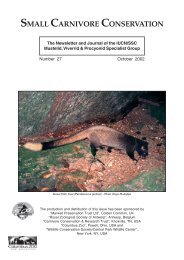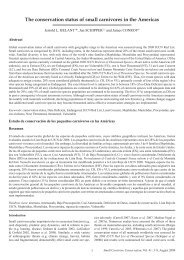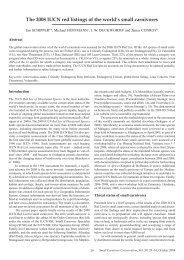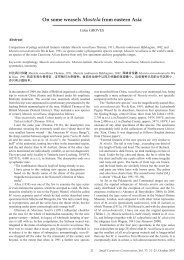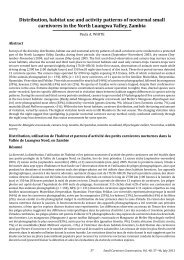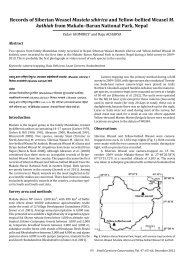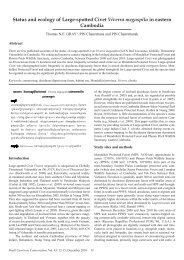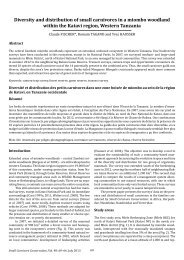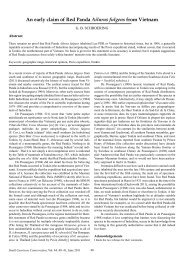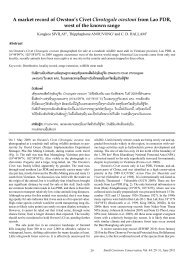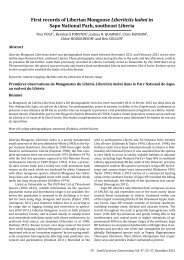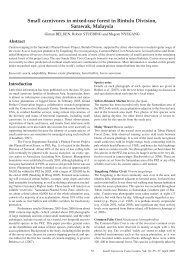Recent records of the Javan Small-toothed Palm Civet Arctogalidia ...
Recent records of the Javan Small-toothed Palm Civet Arctogalidia ...
Recent records of the Javan Small-toothed Palm Civet Arctogalidia ...
Create successful ePaper yourself
Turn your PDF publications into a flip-book with our unique Google optimized e-Paper software.
<strong>Javan</strong> <strong>Small</strong>-too<strong>the</strong>d <strong>Palm</strong> <strong>Civet</strong>for observers to document <strong>the</strong>ir observations, or search for <strong>the</strong> animalsin <strong>the</strong> first place, is no doubt much lower than if it were seenas a species endemic to Java. Therefore, <strong>the</strong> present compilationdocuments recent <strong>records</strong> <strong>of</strong> <strong>Small</strong>-too<strong>the</strong>d <strong>Palm</strong> <strong>Civet</strong> in Java ina taxonomic and conservation context.<strong>Recent</strong> <strong>records</strong>Two observers, JAE and JH, independently photographed <strong>Small</strong>too<strong>the</strong>d<strong>Palm</strong> <strong>Civet</strong>s feeding at a large fruiting fig Ficus by <strong>the</strong>Cikaniki research station, Gunung Halimun National Park (NP),West Java (6°44′48.50″S, 106°32′15.18″E; 1,000 m altitude). JAEvisited this area on 15–16 June and 3–4 July 2008, and 20–21 July2009: he saw palm civets each time, concluding from multiplechecks that <strong>the</strong>y were in <strong>the</strong> tree continually from dusk to dawnon those nights. Maxima in view at one time were four Common<strong>Palm</strong> <strong>Civet</strong>s Paradoxurus hermaphroditus and five <strong>Small</strong>-too<strong>the</strong>d<strong>Palm</strong> <strong>Civet</strong>s. Of <strong>the</strong> latter, at least three were typical in colour <strong>of</strong><strong>the</strong> genus (Fig. 1), but two were beige in tone (Fig. 2). JH saw atleast two beige <strong>Small</strong>-too<strong>the</strong>d <strong>Palm</strong> <strong>Civet</strong>s (Fig. 3) and a Common<strong>Palm</strong> <strong>Civet</strong> on <strong>the</strong> night <strong>of</strong> 4–5 July 2010 during repeatedchecks at <strong>the</strong> tree between dusk and midnight; at least one beige<strong>Small</strong>-too<strong>the</strong>d <strong>Palm</strong> <strong>Civet</strong> was present <strong>the</strong> next night. Suyanto(2003: 73) listed <strong>Small</strong>-too<strong>the</strong>d <strong>Palm</strong> <strong>Civet</strong> for Cikaniki but referenceto Yossa et al. (1991) suggests that this may have been basedsolely on local people’s reports. Moreover, an earlier account <strong>of</strong><strong>the</strong> area’s mammals (Yoneda et al. 1998) stated that <strong>the</strong> specieswas not camera trapped, seen or found by any o<strong>the</strong>r method <strong>the</strong>re,although nei<strong>the</strong>r <strong>the</strong> methods used, nor <strong>the</strong>ir coverage and intensity,were fully detailed.Gunung Halimun NP comprises about 400 km², over600–1,927 m a.s.l., <strong>of</strong> largely primary submontane forest and retainsa rich mammal fauna including much decreased species suchas <strong>Javan</strong> Gibbon Hylobates moloch and <strong>the</strong> <strong>Javan</strong> race <strong>of</strong> LeopardP. pardus melas (Suyanto 2003). Cikaniki research station is in <strong>the</strong>interior <strong>of</strong> <strong>the</strong> park. The animals observed by JAE fed by ‘fruitpressing’(see Duckworth & Nettelbeck 2008), squeezing out juicefrom <strong>the</strong> fig in <strong>the</strong> mouth, <strong>the</strong>n dropping <strong>the</strong> residue.Van Bemmel (1952: 39) concluded, from examining 16<strong>Small</strong>-too<strong>the</strong>d <strong>Palm</strong> <strong>Civet</strong> skins and mounted specimens from Java,and observing an adult female with two young, that individuals <strong>of</strong><strong>the</strong> <strong>Javan</strong> taxon darkened with age, “passing from pinkish buffvia avellaneous, cinnamon buff, clay colour and buckthorn brownto wood brown”. At his time <strong>of</strong> observations, JAE was unaware<strong>of</strong> this text, and independently considered that <strong>the</strong> beige animalswere youngsters based on <strong>the</strong>ir size and build. The recently photographedanimals are not identical in appearance with each o<strong>the</strong>r,for example, in colour <strong>of</strong> <strong>the</strong> distal half <strong>of</strong> <strong>the</strong> tail (compare Fig.2 with 3). Apparent differences in body pelage colour at Cikaniki(compare Fig. 3 with 2), while perhaps in part reflecting differentlighting, and JAE’s aging <strong>of</strong> those animals, are consistent with vanBemmel’s (1952) conclusion that animals darken with age.CRS saw one live <strong>Small</strong>-too<strong>the</strong>d <strong>Palm</strong> <strong>Civet</strong> for sale in aJakarta pet market during trade surveys spread over a few days(recording in total 37 carnivores) in April 2010, but it did not resemble<strong>the</strong> <strong>Javan</strong> taxon. In its pelage, particularly its dark head,it was typical <strong>of</strong> animals on Sumatra and it quite plausibly camefrom that island; many animals traded in Java come from o<strong>the</strong>rislands in Indonesia (Shepherd et al. 2004, Shepherd 2006). Fur<strong>the</strong>rvisits by CRS and by B. Yaap and M. Hill in <strong>Javan</strong> markets in2010 found no o<strong>the</strong>r <strong>Small</strong>-too<strong>the</strong>d <strong>Palm</strong> <strong>Civet</strong>s.Field identificationWith a good view, <strong>Small</strong>-too<strong>the</strong>d <strong>Palm</strong> <strong>Civet</strong> is so distinctive inhead structure and thus facial expression it cannot be confusedwith any native genus within its range. Similarly, <strong>the</strong> tail, verylong even for a palm civet, and looking tubular and s<strong>of</strong>tly woolly,differs from o<strong>the</strong>r South-east Asian species. In Java, <strong>the</strong> onlyconceivable native confusion species is Common <strong>Palm</strong> <strong>Civet</strong>, although<strong>the</strong> heavy live animal ‘pet’ trade means that non-nativespecies are sometimes seen at large (e.g. Masked <strong>Palm</strong> <strong>Civet</strong>Paguma larvata; Brooks & Dutson 1994).Because <strong>the</strong>ir build looks identical to that <strong>of</strong> typically-pelagedanimals, <strong>the</strong> beige animals are readily identifiable as <strong>Small</strong>-too<strong>the</strong>d<strong>Palm</strong> <strong>Civet</strong>s on some photographs (Figs 2–3). From o<strong>the</strong>r angles,identification from a single image is more difficult. For example,<strong>the</strong> apparent head shape <strong>of</strong> individuals in some images (Fig. 4)led RWi, JWD and C. P. Groves (in litt. 2010) initially to suspect<strong>the</strong> animals might be Common, not <strong>Small</strong>-too<strong>the</strong>d, <strong>Palm</strong> <strong>Civet</strong>s,until seeing o<strong>the</strong>r images <strong>of</strong> each series. Under good field conditions,<strong>the</strong>re should be no difficulty identifying animals because <strong>the</strong>features <strong>of</strong> build should be apparent at most angles, in addition to<strong>the</strong> very different styles <strong>of</strong> arboreal motion <strong>of</strong> <strong>the</strong> two species (seeDuckworth 1997).Common <strong>Palm</strong> <strong>Civet</strong> is so variable in pelage that numerousinvalid taxa have been named; Corbet & Hill (1992) listed nearly40 species-level synonyms <strong>of</strong> which only a small proportionare likely to represent valid races. This variability suggests thatbeige-toned Common <strong>Palm</strong> <strong>Civet</strong>s might occur. In this context isan extraordinary fur<strong>the</strong>r recent civet record. During March 2010,RWü visited an advertised ‘marine turtle conservation facility’ atTanjung Benoa, Bali, Indonesia. This turned out to be a third-classcommercial tourist attraction, where visitors can handle BrahminyKite Haliastur indus, Wrea<strong>the</strong>d Hornbill Aceros undulatusand pythons Python. A dark, locked box, opened only after someinsistence, held four subadult palm civets (Fig. 5). The people atTanjung Benoa had no idea what <strong>the</strong>se animals were, and RWümade no enquiry about <strong>the</strong>ir origin; <strong>the</strong>y are likely to have beenbought at a street market, with no possibility <strong>of</strong> determining <strong>the</strong>irorigin, even to island.The identity <strong>of</strong> <strong>the</strong>se Bali captives is uncertain, even thoughtwo clear photographs were taken and three heads in differentpostures can be seen (in <strong>the</strong> two images, each animal is in almost<strong>the</strong> same respective position). The captives do not resemble, inbuild <strong>of</strong> ei<strong>the</strong>r head or tail, typical <strong>Small</strong>-too<strong>the</strong>d <strong>Palm</strong> <strong>Civet</strong>s.The ears seem too close toge<strong>the</strong>r, including on <strong>the</strong> animal lookingdirectly at <strong>the</strong> camera where <strong>the</strong> appearance should be leastdistorted by orientation. While <strong>the</strong>ir overall facial mien looksalso unlike Common <strong>Palm</strong> <strong>Civet</strong> to most observers, whe<strong>the</strong>r thisreflects anything structural, ra<strong>the</strong>r than being a side effect <strong>of</strong> <strong>the</strong>irstrange colour, is difficult to judge. They are young animals,which tend to have scrawnier-looking tails than do adults (e.g.Fig. 6): <strong>the</strong> tails <strong>of</strong> <strong>the</strong>se animals could be consistent with ei<strong>the</strong>rgenus. An odd head-shape as an effect <strong>of</strong> age seems less plausible,and is not suggested by young <strong>Small</strong>-too<strong>the</strong>d <strong>Palm</strong> <strong>Civet</strong>sfrom Borneo and Sumatra (Fig. 6). Moreover, eyes are noticeablylarger in adult <strong>Small</strong>-too<strong>the</strong>d <strong>Palm</strong> <strong>Civet</strong>s than in adult Common<strong>Palm</strong> <strong>Civet</strong>s, and <strong>the</strong>se young <strong>Small</strong>-too<strong>the</strong>d <strong>Palm</strong> <strong>Civet</strong>s from<strong>the</strong> o<strong>the</strong>r Greater Sunda islands have eyes looking <strong>of</strong> almost tar-17<strong>Small</strong> Carnivore Conservation, Vol. 43, December 2010
Eaton et al.sensible starting area. Hoogerwerf (1970: 414) wrote that “...itwas only observed once for certain in Udjung Kulon, viz. on 18July 1939; in <strong>the</strong> late afternoon two were seen on a forest pathnear <strong>the</strong> Tjikarang; <strong>the</strong>y moved slowly away on <strong>the</strong> author’s approach...”.Such behaviour would be extraordinary in <strong>the</strong> o<strong>the</strong>rtaxa <strong>of</strong> this arboreal, nocturnal, genus, and it should not be seenas typical <strong>of</strong> <strong>the</strong> <strong>Javan</strong> taxon without corroboration. O<strong>the</strong>rwise,<strong>the</strong> limited information available suggests that A. (t.) trilineatais as arboreal and nocturnal as are <strong>the</strong> populations elsewhere in<strong>the</strong> genus’s range (van Bemmel 1952; recent observations). Therefore,spotlight surveys would speedily inform whe<strong>the</strong>r <strong>the</strong> taxon isany sort <strong>of</strong> conservation priority (and would also give informationon <strong>the</strong> loris and chevrotain). At least in Lao PDR, detection ratesseem to vary with season, being higher in <strong>the</strong> hot season, partlybecause at that time <strong>of</strong> year <strong>Small</strong>-too<strong>the</strong>d <strong>Palm</strong> <strong>Civet</strong>s frequentlygive characteristic loud calls, but also apparently reflecting highergeneral activity <strong>the</strong>n (Duckworth 1997). There seems to be noinformation about possible such seasonality in Java, so if earlyspotlighting surveys fail to find <strong>the</strong> species, as well as seeking itat fur<strong>the</strong>r sites, attempts at o<strong>the</strong>r times <strong>of</strong> year may be important.More intensive trade surveys could provide useful indications, butestablishing origins <strong>of</strong> animals would be difficult, and interpretingnumbers found would be no more easy. For an arboreal nocturnalspecies, a lack or rarity <strong>of</strong> trade <strong>records</strong> might reflect limited use<strong>of</strong> hunting techniques suitable to catch it alive, a genuine rarity<strong>of</strong> <strong>the</strong> animal, or some combination. Hence, field searches are essential.One innovative method <strong>of</strong> detecting <strong>the</strong> animal could be examination<strong>of</strong> alimentary tracts <strong>of</strong> large snakes in <strong>the</strong> reptile skintrade industry on Java, which is large (R. Melisch in litt. 2010).<strong>Small</strong>-too<strong>the</strong>d <strong>Palm</strong> <strong>Civet</strong>s have been found in <strong>the</strong> tracts <strong>of</strong> harvestedReticulated Pythons Python reticulatus in Sumatra (Shineet al. 1999) and although that study found <strong>the</strong>m only rarely (two<strong>of</strong> 163 identified prey items), liaison with any investigations <strong>of</strong>large-snake diet in Java could result in <strong>records</strong>.The identification <strong>of</strong> <strong>Small</strong>-too<strong>the</strong>d <strong>Palm</strong> <strong>Civet</strong> in Java requiresgreat care and, unless it be documented to be widespreadand at least reasonably common, <strong>records</strong> should be publishedmaking explicit <strong>the</strong> basis for identification.The urgency for a detailed investigation <strong>of</strong> intrageneric taxonomy<strong>of</strong> <strong>Arctogalidia</strong> is, as with so much else concerning <strong>the</strong><strong>Javan</strong> taxon, unclear. If A. (t.) trilineata be a taxon <strong>of</strong> conservationconcern, <strong>the</strong>n a misleading treatment as a mere subspecieswill handicap conservation efforts on its behalf. However, if it besimply much overlooked, <strong>the</strong>n given <strong>the</strong> various o<strong>the</strong>r impendingmammalian conservation crises on Java urgently needing betterinformation for effective conservation interventions, taxonomicinvestigation would be <strong>of</strong> low priority.AcknowledgementsWe thank <strong>the</strong> Mammal Section, Natural History Museum, London; MuseumZoologicum Bogoriense, Cibinong, Bogor, Indonesia; and <strong>the</strong> Rijksmuseumvoor Natuurlijke Historie (National Museum <strong>of</strong> Natural History;‘Naturalis’), Leiden, Ne<strong>the</strong>rlands for access to specimens. We thankBetsy Yaap, Dave Ware, Joe Walston, Géraldine Veron, Louise Tomsett,Alexander Sliwa, Klaus Rudl<strong>of</strong>f, Johannes Pfleiderer, Belden Giman Neilson,Jonathan Murray, Roland Melisch, Erik Meijaard, James F. Maxwell,John Mathai, Jonas Livet (http://www.leszoosdanslemonde.com), AndyJennings, Madeline Hill, Colin Groves, Lon Grassman Jr, Craig Furmage,Neil Franklin, Nick Brickle, Thiemo Braasch and Jerry Belant for adviceand assistance, including permitting <strong>the</strong> use <strong>of</strong> photographs.ReferencesBartels, M., Jr 1937. Zur Kenntnis der Verbreitung und der Lebensweise<strong>Javan</strong>ische Säugetiere. Treubia 16: 149–164.Bartels, M., Jr 1941. Iets over de “Loewaks” en verwante kleine ro<strong>of</strong>dierenvan Java. Nederlandsch-Indische Jager (Maandblad von hetNederlandsch-Indisch Jagersgenootschap, Batavia) 11: 172–176.Belden, G., Stuebing, R., & Nyegang, M. 2007. <strong>Small</strong> carnivores inmixed-use forest in Bintulu division, Sarawak, Malaysia. <strong>Small</strong> CarnivoreConservation 36: 35–37.Borissenko, A. V., Ivanova, N. V. & Polet, G. 2004. First recent record <strong>of</strong><strong>the</strong> <strong>Small</strong>-too<strong>the</strong>d <strong>Palm</strong> <strong>Civet</strong> <strong>Arctogalidia</strong> trivirgata from Vietnam.<strong>Small</strong> Carnivore Conservation 30: 5–6.Brandon-Jones, D., Eudey, A. A., Geissmann, T., Groves, C. P., Melnick,D. J., Morales, J. C., Shekelle, M. & Stewart, C.-B. 2004. Asianprimate classification. International Journal <strong>of</strong> Primatology 25:97–164.Brooks, T. M. & Dutson, G. C. L. 1994. A sighting <strong>of</strong> a Masked <strong>Palm</strong><strong>Civet</strong> (Paguma larvata) on Java. <strong>Small</strong> Carnivore Conservation 11:19.Corbet, G. B. & Hill, J. E. 1992. The mammals <strong>of</strong> <strong>the</strong> Indomalayan region.Natural History Museum Publications and Oxford UniversityPress, Oxford, U.K.Cranbrook, Earl <strong>of</strong>, Payne, J. & Leh, C. M. U. 2007. Origin <strong>of</strong> <strong>the</strong> ElephantsElephas maximus L. <strong>of</strong> Borneo. Sarawak Museum Journal63 (N.S. 84): 95–125.Duckworth, J. W. 1997. <strong>Small</strong> carnivores in Laos: a status review withnotes on ecology, behaviour and conservation. <strong>Small</strong> CarnivoreConservation 16: 1–21.Duckworth, J. W. & Nettelbeck, A. R. 2008. Observations <strong>of</strong> <strong>Small</strong>too<strong>the</strong>d<strong>Palm</strong> <strong>Civet</strong>s <strong>Arctogalidia</strong> trivirgata in Khao Yai NationalPark, Thailand, with notes on feeding technique. Natural HistoryBulletin <strong>of</strong> <strong>the</strong> Siam Society 55: 187–192.Duckworth, J. W., Roberton, S. I. & Brickle, N. W. 2008. Fur<strong>the</strong>r notes on<strong>Javan</strong> Ferret Badger Melogale orientalis at Gunung Gede PangrangoNational Park, Java. <strong>Small</strong> Carnivore Conservation 39: 39–40.Gippoliti, S. & Meijaard, E. 2007. Taxonomic uniqueness <strong>of</strong> <strong>the</strong> <strong>Javan</strong>Leopard; an opportunity for zoos to save it. Contributions to Zoology76: 55–58.Goodman, S. M. & Helgen, K. M. 2010. Species limits and distribution <strong>of</strong><strong>the</strong> Malagasy carnivoran genus Eupleres (Family Eupleridae). Mammalia74: 177–185.‘Grey Owl’ 1942. Loewaks. Nederlandsch-Indische Jager (Maandbladvon het Nederlandsch-Indisch Jagersgenootschap, Batavia) 12: 19.Groves, C. 2007. On some weasels Mustela from eastern Asia. <strong>Small</strong>Carnivore Conservation 37: 21–25.Harrison, J. L. 1968. The effect <strong>of</strong> forest clearance on small mammals.Pp. 153–158 in Talbot, L. M. & Talbot, M. H. (eds) Conservation intropical South East Asia. Proceedings <strong>of</strong> <strong>the</strong> conference on conservation<strong>of</strong> nature and natural resources in tropical South East Asia.Bangkok, Thailand. IUCN, Morges, Switzerland (Publications newseries, n° 10).Hoogerwerf, A. 1970. Udjung Kulon, <strong>the</strong> land <strong>of</strong> <strong>the</strong> last <strong>Javan</strong> Rhinoceros.E. J. Brill, Leiden, Ne<strong>the</strong>rlands.Lekagul, B. & McNeely, J. A. 1977. Mammals <strong>of</strong> Thailand. Associationfor <strong>the</strong> Conservation <strong>of</strong> Wildlife, Bangkok, Thailand (revised 1988printing).Low, C. H. S. 2010. Observations <strong>of</strong> civets on Fraser’s Hill, PeninsularMalaysia. <strong>Small</strong> Carnivore Conservation 43 [[[Divya: please fill in<strong>Small</strong> Carnivore Conservation, Vol. 43, December 201020
<strong>Javan</strong> <strong>Small</strong>-too<strong>the</strong>d <strong>Palm</strong> <strong>Civet</strong>page numbers]]].Mazák, J. H. & Groves, C. P. 2006. A taxonomic revision <strong>of</strong> <strong>the</strong> Tigers(Pan<strong>the</strong>ra tigris) <strong>of</strong> Sou<strong>the</strong>ast Asia. Zeitschrift für Säugetierkunde71: 268–287.Meijaard, E. in press. Family Tragulidae (chevrotains). In Wilson, D. E.& Mittermeier, R. A. (eds) Handbook <strong>of</strong> <strong>the</strong> mammals <strong>of</strong> <strong>the</strong> world,vol. 2. Lynx Edicions, Barcelona, Spain.Meijaard, E. & Groves, C. P. 2004. A taxonomic revision <strong>of</strong> <strong>the</strong> Tragulusmouse-deer (Artiodactyla). Zoological Journal <strong>of</strong> <strong>the</strong> Linnean Society140: 63–102.Meiri, S., Duckworth, J. W. & Meijaard, E. 2007. Biogeography <strong>of</strong> IndonesianMountain Weasel Mustela lutreolina and a newly discoveredspecimen. <strong>Small</strong> Carnivore Conservation 37: 1–5.Nekaris, K. A. I., Blackham, G. V. & Nijman, V. 2008. Conservation implications<strong>of</strong> low encounter rates <strong>of</strong> five nocturnal primate species (Nycticebusspp.) in Asia. Biodiversity and Conservation 17: 733–747.Pocock, R. I. 1933. The rarer genera <strong>of</strong> Oriental Viverridae. Proceedings<strong>of</strong> <strong>the</strong> Zoological Society <strong>of</strong> London ‘1933’: 969–1035.Pocock, R. I. 1939. The fauna <strong>of</strong> British India, including Ceylon and Burma.Mammalia, 2nd ed., vol. I. Taylor & Francis, London, U.K.Santiapillai, C. & Ramono, W. S. 1992. Status <strong>of</strong> <strong>the</strong> Leopard (Pan<strong>the</strong>rapardus) in Java, Indonesia. Tigerpaper 19(2): 1–5.Schreiber, A., Wirth, R., Riffel, M., & Van Rompaey, H. 1989. Weasels,civets, mongooses, and <strong>the</strong>ir relatives: an action plan for <strong>the</strong> conservation<strong>of</strong> mustelids and viverrids. IUCN, Gland, Switzerland.Semiadi, G. & Meijaard, E. 2006. Declining populations <strong>of</strong> <strong>the</strong> <strong>Javan</strong>Warty Pig (Sus verrucosus). Oryx 40: 50–56.Shepherd, C. R. 2006. The bird trade in Medan, north Sumatra: an overview.Birding Asia 5: 16–24.Shepherd, C. R. 2008. <strong>Civet</strong>s in trade in Medan, North Sumatra, Indonesia(1997–2001) with notes on legal protection. <strong>Small</strong> CarnivoreConservation 38: 34–36.Shepherd, C. R., Sukumaran, J. & Wich, S. A. 2004. Open season: ananalysis <strong>of</strong> <strong>the</strong> pet trade in Medan, Sumatra, 1997–2001. TRAFFICSou<strong>the</strong>ast Asia, Petaling Jaya, Selangor, Malaysia.Shine, R., Ambaryianto, Harlow, P. S. & Mumpuni 1999. Reticulated Pythonsin Sumatra: biology, harvesting and sustainability. BiologicalConservation 87: 349–357.Suyanto, A. 2003. Mammals <strong>of</strong> Gunung Halimun National Park, WestJava. Puslit Biologi, LIPI, Bogor, Indonesia.Tobias, J. A., Seddon, N., Spottiswoode C. N., Pilgrim, J. D., Fishpool, L.D. C. & Collar, N. J. 2010. Quantitative criteria for species delimitation.Ibis 152: 724–726.van Bemmel, A. C. V. 1952. Contribution to <strong>the</strong> knowledge <strong>of</strong> <strong>the</strong> generaMuntiacus and <strong>Arctogalidia</strong> in <strong>the</strong> Indo-Australian archipelago(Mammalia, Cervidae & Viverridae). Beaufortia 2 (16): 1–50.Wells, K., Bium, A. & Gabin, M. 2005. Viverrid and herpestid observationsby camera and small mammal cage trapping in <strong>the</strong> lowlandrainforests on Borneo including a record <strong>of</strong> <strong>the</strong> Hose’s <strong>Civet</strong>,Diplogale hosei. <strong>Small</strong> Carnivore Conservation 32: 12–14.Wilting, A., Samejima, H. & Mohamed, A. 2010. Diversity <strong>of</strong> Borneanviverrids and o<strong>the</strong>r small carnivores in Deramakot Forest Reserve,Sabah, Malaysia. <strong>Small</strong> Carnivore Conservation 42: 10–13.WWF Vietnam 2010. Rarest <strong>of</strong> <strong>the</strong> rare: <strong>Javan</strong> Rhinoceros Rhinoceros sondaicusannamiticus: rare <strong>Javan</strong> Rhino death in Cat Tien National Park,Vietnam. Babbler (Birdlife International in Indochina) 34: 32–33.Yoneda, M., Ladjar, L. N. & Sakaguchi, N. 1998. Camera trap study inCikaniki, Gunung Halimun National Park. Pp. 96–104 in Simbolon,H., Yoneda, M. & Sugardjito, J. (eds) Gunung Halimun: <strong>the</strong> lastsubmontane tropical forest in West Java. Research and Conservation<strong>of</strong> Biodiversity in Indonesia, vol IV. LIPI–JICA–PHPA BiodiversityConservation Project in Indonesia, Bogor, Indonesia.Yossa, I., Navy, P., Dolly, P., Yudha, N., Azwar & Yosias, M. 1991. Survey<strong>of</strong> <strong>the</strong> carnivores <strong>of</strong> Gunung Halimun Nature Reserve, Java.Mustelid & Viverrid Conservation 5: 3.117 Keats Avenue, Littleover, Derby, DE23 4EE,United Kingdom.Email: jameseaton@birdtourasia.com2ZGAP-FbP, Faberstr. 4, D-70188, Stuttgart,Germany.Email: rene.wuest@zgap.de3Zoologische Gesellschaft für Arten- undPopulationsschutz, Untertaxetweg 144, 82131 Gauting,Germany.Email: roland.wirth@zgap.de4Puslit Biologi LIPI, Jl. Raya Jakarta-Bogor Km. 46,Cibinong 16911, Jawa Barat, Indonesia.Email: semiadi@gmail.com5TRAFFIC Sou<strong>the</strong>ast Asia, Unit 3-2, 1st Floor,Jalan SS23/11, Taman SEA, 47400 Petaling Jaya,Selangor, Malaysia.Email: cstsea@po.jaring.my62 rue André Pascal, Paris, France 75775.Email: jonhall1@gmail.com73 Camerton Close, Saltford, Bristol BS31 3BT, UK.Email: willduckworthdprk@yahoo.comFigures (on back cover)Fig. 1. Adult <strong>Javan</strong> <strong>Small</strong>-too<strong>the</strong>d <strong>Palm</strong> <strong>Civet</strong> <strong>Arctogalidia</strong>(trivirgata) trilineata, Cikaniki Research Station, Gunung HalimunNational Park, Java, 2 July 2008 (Photot: J. A. Eaton).Fig. 2. Beige-coloured, presumed young, <strong>Javan</strong> <strong>Small</strong>-too<strong>the</strong>d<strong>Palm</strong> <strong>Civet</strong> <strong>Arctogalidia</strong> (trivirgata) trilineata, Cikaniki ResearchStation, Gunung Halimun National Park, Java, 16 June 2008(Photo: J. A. Eaton).Fig. 3. Beige-coloured, presumed young, <strong>Javan</strong> <strong>Small</strong>-too<strong>the</strong>d<strong>Palm</strong> <strong>Civet</strong>s <strong>Arctogalidia</strong> (trivirgata) trilineata, Cikaniki ResearchStation, Gunung Halimun National Park, Java, (a) 5 July 2010,(b) 4 July 2010 (Photos: J. Hall).Fig. 4. Beige-coloured, presumed young, <strong>Javan</strong> <strong>Small</strong>-too<strong>the</strong>d<strong>Palm</strong> <strong>Civet</strong>s <strong>Arctogalidia</strong> (trivirgata) trilineata, Cikaniki ResearchStation, Gunung Halimun National Park, Java, (a) 4 July 2010(Photo: J. Hall), (b) 16 June 2008 (Photo: J. A. Eaton). Note <strong>the</strong>dark pinnae except for <strong>the</strong> proximal interior, which is pink. At <strong>the</strong>angle <strong>of</strong> viewing <strong>of</strong> Fig.4a, <strong>the</strong> head structure is less obviouslythat <strong>of</strong> <strong>Small</strong>-too<strong>the</strong>d <strong>Palm</strong> <strong>Civet</strong>.Fig. 5. Unidentified captive palm civets, Tanjung Benoa, Bali,March 2010 (Photo: R. Wüst).Fig. 6. <strong>Small</strong>-too<strong>the</strong>d <strong>Palm</strong> <strong>Civet</strong>s <strong>Arctogalidia</strong> trivirgata,showing structure <strong>of</strong> young animals in Borneo and Sumatra.(a) RT Setimbo, West Kalimantan (kept behind a village house21<strong>Small</strong> Carnivore Conservation, Vol. 43, December 2010
Eaton et al.as a pet; caught locally), 25 October 2008 (Photo: B. Yaap); (b)Binyo-Penyilam Conservation Area, Bintulu, Sarawak, Malaysia,2006 (Photo: Rose Ragai / Sarawak Planted Forests); (c) BukitTigapuluh forest block, border <strong>of</strong> Riau and Jambi provinces,Sumatra, October 2004 (Photo: N. Franklin, Sumatran TigerConservation Program).Fig. 7. <strong>Javan</strong> <strong>Small</strong>-too<strong>the</strong>d <strong>Palm</strong> <strong>Civet</strong>s <strong>Arctogalidia</strong> (trivirgata)trilineata in Museum Zoologicum Bogoriense, Cibinong, Bogor,Indonesia. Upper: MZB 7113 from Gamboeng, Pengalengan,Preanger, West Java, May 1912 (collector T. H. Kerkoeen; Photo:G. Semiadi).Fig. 8. Common <strong>Palm</strong> <strong>Civet</strong>s Paradoxurus hermaphroditus,Natural History Museum, London, UK, showing remarkablevariation but presence <strong>of</strong> dark face-mask in all but <strong>the</strong> albino.Left to right: BMNH 58.5.4.1, origin unknown (via ZoologicalSociety <strong>of</strong> London); BMNH 98.8.25.1 from Kondmals, Orissa,India, nineteenth century (Collector J. Taylor); BMNH 10.4.6.41from Kangean island, Java Sea, 20 November 1909 (Collector: G.C. Shortridge); BMNH 81.12.2.3 from Kyeikpadein, lower Pegu,Myanmar, 25 August 1879 (Collector: E. Oates; Photo: J. W.Duckworth, © Natural History Museum).Fig. 9. <strong>Javan</strong> <strong>Small</strong>-too<strong>the</strong>d <strong>Palm</strong> <strong>Civet</strong> <strong>Arctogalidia</strong> (trivirgata)trilineata, Rijksmuseum voor Natuurlijke Historie, Leiden (Photo:R. Wirth).Fig. 10. Common <strong>Palm</strong> <strong>Civet</strong> Paradoxurus hermaphroditus,bleached with hydrogen peroxide, Pramuka markets, Java, 19June 2010 (Photo: C. Furmage).Fig. 11. <strong>Small</strong>-too<strong>the</strong>d <strong>Palm</strong> <strong>Civet</strong>s <strong>Arctogalidia</strong> trivirgata from(a) Phu Khieo Wildlife Sanctuary, Thailand (16° 22′17.26″N,101°35′19.91″E; 900 m asl), representative <strong>of</strong> <strong>the</strong> leucotissubspecies-group (17 March 2002; Photo: L. Grassman); and (b)Murud Kecil, upper Baram drainage, Sarawak, Malaysia (3°23′N,115°13′E), representative <strong>of</strong> <strong>the</strong> trivirgata subspecies-group (15June 2004; Photo: WCS Malaysia).Fig. 12. <strong>Javan</strong> <strong>Small</strong>-too<strong>the</strong>d <strong>Palm</strong> <strong>Civet</strong>s <strong>Arctogalidia</strong> (trivirgata)trilineata, Cikaniki Research Station, Gunung Halimun NationalPark, Java; presumed adult, 2 July 2008 (Photo: J. A. Eaton).<strong>Small</strong> Carnivore Conservation, Vol. 43, December 201022



